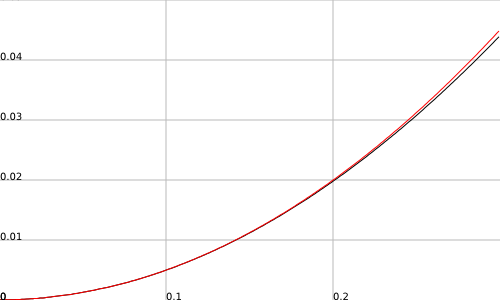I am working on a game idea that involves (special) relativistic mechanics instead of classical mechanics. Working out the details that I needed was easy enough if I assumed that:
- ships had a maximum speed at which they could move relative to my base frame
- ships could instantly go from stopped to maximum speed or vice-versa
I didn’t like those assumptions at all. So, I started playing with the equations for relativity. In classical mechanics, the rate-of-change of velocity equals the force you’re applying divided by your mass: .
In special relativity, your mass increases with velocity. So, that equation becomes: (assuming units where the speed of light is 1 unit of distance per 1 unit of time and
is your rest-mass).
For the purposes of this post, I’m going to assume the simplest initial conditions: you start motionless and at the origin. For ease of notation, let . Solving the above differential equation to get a formula for velocity and solving the resulting differential equation to get the distance
you’ve travelled in my base frame by time
, the answer comes out to:
.
I have solved this problem at least thirty times in the past two months. Sometimes I used the simple initial conditions as above. Sometimes I did it in all of its gory details (including the messy case where the applied force is not aligned with the current velocity).
I got the same answer (well, plus the extra mess when I did the full-on problem) every way that I tried it.
So, why did I do it over and over again?
If this were classical mechanics, the end equation would have been . And, I know that for low velocities, the classical mechanics answer should be almost identical to the special relativity answer. And, there was no way that I thought
.
I knew what the graph looked like when
. It is a straight line. It doesn’t look much like the parabola
at all.
My assumption was that since was a straight line for
, then
would be a straight line shifted up one unit and bent (concave-down) a little bit like the graph of
is bent.
Boy was I wrong. Here is a plot of the two together (created with fooplot). The red line is the classical mechanics version. The black line is the relativistic version. Here, the force is such that the body is accelerating at a rate of the speed of light per second
so they’ve already gotten up to around 28,000 miles per second before you can see any separation in the graphs here.
Definitely, I can see the resemblance. Now, to fix my intuition about square-roots.


Interestingly, the looks eerily close to an approximation that I once saw for two-dimensional distance. Doing a little algebra, one comes up with
looks eerily close to an approximation that I once saw for two-dimensional distance. Doing a little algebra, one comes up with  .
.
The 2-D distance approximation formula was that . The relativity/classical approximation above seems to be
. The relativity/classical approximation above seems to be  for this early portion where
for this early portion where  .
.
I really like the idea of a game where the speed of light is 1 m/s or whatever. It’s basically a Gamow’s “Mr. Tompkins in Wonderland”, the game. It took me an embarrassing long time to find the name of this work considering I work in a building named in his honor. If you haven’t read it, it might give a good foundation for all of the concepts involved without reading something more in depth. There is a copy at http://www.arvindguptatoys.com/arvindgupta/tompkins.pdf. I think the tricky bit will be the time dilation effects and the finite information propagation time.
If your curious, the approximation $\sqrt{1+a^2t^2} \approx 1+\frac{a^2 t^2}{2} – \frac{(a^2 t^2)^2}{8} + \cdots$ is a Taylor expansion for small $a^2 t^2$. I’m sure about that min/max stuff or where it came from. Remember that at a large enough value of $a^2 t^2$, the 1 under the square root becomes negligible and this should basically equal $at$ (a straight line like your intuition told you), not $a^2 t^2$.
I will check out “Mr. Tompkins”. Thanks.
And, yes, I knew that for big enough t, it had to be almost a straight line (with slope speed-of-light). I was just thinking that given what looks like compared to
looks like compared to  would be relevant for
would be relevant for  compared to
compared to  . And, so I thought that I was ending up with an equation where the instantaneous velocity at the start is unbounded and eventually comes down to the speed-of-light. I should have doubted my intuition long before the 30-th derivation.
. And, so I thought that I was ending up with an equation where the instantaneous velocity at the start is unbounded and eventually comes down to the speed-of-light. I should have doubted my intuition long before the 30-th derivation.